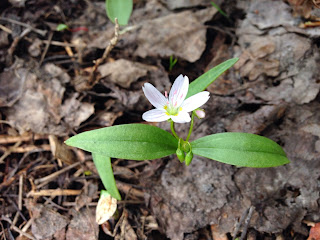 |
| Claytonia lanceolata |
The flowers of Spring Beauty deserve the name, bright white or sometimes pinkish with yellow spots at the base of the petals and pink anthers at the ends of the stamens. If you look closely, you can notice a relatively unusual feature of only a few families of flowers; the stamens grow opposite the petals instead of alternate with them. That means the stamens grow from the center point of the petals, instead from the center of the spaces between the petals, as in most flowers. There are usually a few nodding buds waiting their turn to open. It is a small plant, usually only 2-3 inches tall, and the few leaves (usually just one pair) are opposite. I observed a wide range of leaf shapes, with lanceolate (long and tapering at both ends) being most common, but some plants had nearly round leaves. Most roots are quite small, about pea-sized, and have a smooth coating. There are often two or more stems growing from a single root. If you find a good area with lots of Spring Beauties, look for clusters of plants. The larger roots will put up numerous stems, which will emerge from the ground within a few inches of each other at the surface. A large root with 10 or more stems may be an inch across. A good practice would be to look for these larger plants, and put back any pea-sized roots you dig up.
The leaves are very good raw, and in my opinion taste even better than Miner's Lettuce. The leaves are pleasant and slightly thicker and juicier than store-style lettuce, while the stem and flowers have a stronger flavor, with a little kick of spiciness. You will have plenty of these if you have found some larger roots, so an easy way to enjoy the leaves alone is to pinch off the flower cluster, and then bite the pair of leaves off the stem. Or eat it with the flowers and stem to enjoy their spicy kick. Just like Miner's Lettuce, these leaves are high in vitamins C and A.
The roots are best boiled about 5 minutes. After 10 minutes they seemed rather mushy. They have a definite flavor of their own, reminiscent of cooked cauliflower, but stronger, and they sometimes have a curiously pungent after-aroma. But with some salt, pepper, and your favorite variety of grease, they are quite yummy.
(2015 update)
I'm getting better at finding the larger roots this year. The root will send up multiple stems, which spread out and emerge from the soil separately, looking like individual plants. Small roots will only send up one or two stems, so if you see a single spring beauty, you can expect a small root to be under it. The trick is to look for clusters of spring beauties, or better yet, a circle of them. Dig under those, and you can expect to find a nice sized root, about an inch or so across. The picture below is a good example of a large root, with a whole salad growing up out of it.

No comments:
Post a Comment